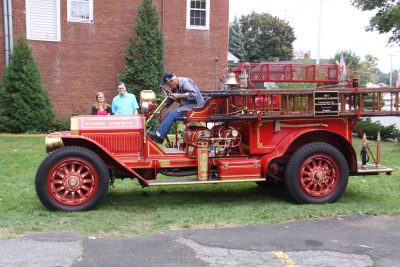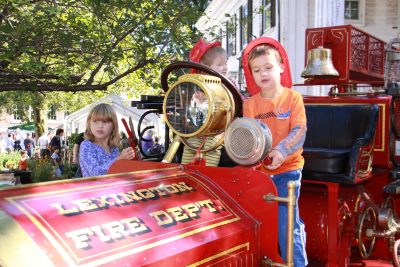From Bucket Brigade to Modern Firefighting

PRE-20TH CENTURY FIRE DEPARTMENT
For a long time in the 19th century, a fire in Lexington was a community affair. The residents all participated, bringing out hand tubs and buckets. In a house fire, neighbors would band together and remove as much personal property as possible. These efforts became somewhat obsessive at times, impeding the firefighters’ efforts.

ln 1829 after some destructive large fires, Town Meeting voted to purchase two engines and two separate sheds built on opposite ends of town to house them. The first Center fire station was in Bowen Harrington’s barn on Waltham Street. The East Village Fire station was located on Pleasant Street, just up from Massachusetts Avenue (then known as Main St). In 1830 the town relied on a manually operated pump machine to fight fires. A hand bucket brigade from the nearest water source would fill the tub.
Nothing more was done until 1856 when the town revisited the need and replaced the hand pumper engines with suction engines called the Hancock No. 2, and the Adams No. 1. The former was kept in the Center, and the Adams in East Lexington. These pulled water from surface water areas by means of a hard hose to the pump.
The two companies were great rivals. According to The Fireman’s Standard (3/1/1915) when the old Lexington House burned, the Waltham and Woburn fire departments had to put it out because the rivalry was so intense. Supposedly, it was customary to have a fire every Saturday night mostly in out-of-way places, which ended up in a loud party.
The brush, house, and barn fires continued. In 1867, the two-building home of a private boarding school for girls, located on now-Massachusetts Avenue at Waltham Street, burned to the ground. Over 150 girls attended the school; luckily, it was not in session. The Boston Fire of 1872 blazed for almost two days, destroying 776 buildings and leaving hundreds jobless and homeless. Subsequently, the Commonwealth enacted legislation to develop the local public safety departments. This impetus spurred the town to examine its fire-fighting capability.
Lexington’s water resources were not sufficient to supply water-throwing fire apparatus that required a continuous supply of water. During the late 1870s, the Town authorized the digging of wells and cisterns for water storage so that a reserve supply would always be available. By 1876, the town had opened a new firehouse at 7 Meriam Street and remodeled East Village Hall for the East Village station.
In 1885 a public water distribution system was introduced in town with a pumping station being built on Lincoln Street, where the sports fields are today. By 1886, the Lexington Water Company laid water lines and installed fire hydrants around the town.
In the early 1890s, horses began to pull the Town’s fire engines rather than the men, but until 1895 the Town relied on the horses owned by the livery stable and neighbors. Given that Lexington was a town of farmers, the horses were often busy during plowing and harvesting seasons, which created problems. Ultimately, the Town bought four horses, housing them in a small shed, and used them to clear the streets during the winter.
In 1888, a telephone connecting the pumping station with the Center and East Village Stations was established to receive fire alarm calls. In turn, the department would call the pumping station to increase the pressure in the mains. In 1890, the Town’s schools were urged to hold fire drills, not only as a safeguard but also as a beneficial gymnastic exercise. The practice drills were said to have emptied the schools in less than two minutes. In 1892, the town approved a $50 expenditure for a steam fire whistle atop the pumping station on Lincoln Street to alert off-duty firefighters.
As the town grew, some newcomers built houses on higher ground further out from the town center, causing delays in reaching them. When a massive fire destroyed Cary Mansion in 1895, the Town realized that the current Fire Department was ineffective in protecting the rapidly increasing population. Because of the scarce water supply and inadequate equipment, the fire destroyed the mansion. The water main system of largely 4-inch pipes was not large enough to supply fire streams; the hydrants were as much as 1500 feet apart. There were 203 dwellings outside the hydrant district; The town appropriated $6,000 to purchase a steam fire engine and a chemical engine and to remodel the Central Station to accommodate horses. Within the next year, a town water system was established, a fire alarm box system was approved, three pieces of firefighting equipment were ordered, the fire department reorganized, and the first permanent firefighter was employed.
By 1900, Lexington’s population was 3,831; the assessed valuation of property was $5,182,000, and the tax rate was set at $15. In 1900, the town was again suffering from a serious water shortage, so it began to purchase water from the Metropolitan District system. A water tower on the top of Concord Hill replaced the Lincoln St. pumping station, and the fire alarm and transmitting equipment were moved to the Meriam Street Station.
In 1911, the department purchased an American La France combination chemical and hose car for the Headquarters Station on Meriam St. In June 1947, the headquarters apparatus moved from Meriam Street to 45 Bedford Street.
The Lexington Fire Department certainly displayed the thrifty nature of New Englanders. Throughout the 20th century, it purchased equipment and rebuilt used equipment to meet their needs. In some cases, Lexington residents donated touring cars, which were rebuilt to meet the station’s needs. In one such case, it rebuilt a used Packard car, which they rebuilt into a combination booster/hose wagon designated as Hose No. 4, From 1948 to the mid-1950s, the Packard was outfitted with a snow plow, and parked in the rear garage at Bedford Street. Used to plow the rear parking lot and the apparatus apron, the Packard needed one man to drive it and the other to put the plow up and down!
TODAY
Completed in 2020, the fire department building is home for 60 firefighter -EMTs, 51 of whom are paramedics trained to provide advanced life support. They are divided into four working groups of 15 personnel, providing fire suppression, EMS, and rescue services from two fire stations. The administrative staff also coordinates Lexington’s emergency management functions.
We are known for having the first woman firefighter: Ann Pastreich in 1980. A Cambridge resident, she was age 37, the mother of two, and reported to LFHQ in November 9, 1980. Since then, Lexington has had nine female firefighters.
The building contains the 1911 American LaFrance pumper, and it attracts many visitors. Chief Sencabaugh has many files, folders, and pictures from the past, which he is organizing in his spare time into a great pictorial gallery. He says, “I am trying to capture as much history as I can, but people keep showing up with additional pictures and stories!” Even our fire department will go down in history.
